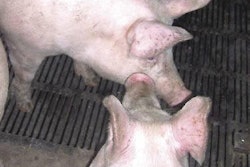
PIGI: Dr Yukol, what is the size of the pig industry in Thailand in round terms at the start of 2009?
DR YUKOL: The data collected in January 2009 has suggested that our country has about 7.5 million pigs on its farms at present. We expect that Thailand will produce approximately 18 million pigs this year. Thai livestock production for domestic consumption and export in 2008 was 3.22 million metric tons, with pork contributing approximately 940,000 metric tons to this total. It was a year when the estimated production in Thailand of all farm animals including poultry increased by 2.81% in volume terms from 2006-2007.
Q: Does your department expect Thailand's pig industry to grow in size in 2009?
A: No, this is not our forecast. I do not think any of the livestock industries will grow over the next 12 months, although feed production may, perhaps, rise. For pigs and other livestock it is more likely that we shall see flat growth this year, mainly because of a reduced consumption of meat caused by the global economic crisis.
Q: Are you expecting, therefore, that the international financial situation will have a marked effect on the development of pig production in 2009?
A:In one important respect the financial situation may not affect the industry directly in this country because Thai producers can still obtain loans from Thailand's banks. However, as the purchasing power of consumers and foreign importers has decreased, we will certainly have negative effects from this crisis. Food and feed prices will be forced to fall so that the products can still be sold, while Thai producers have to maintain the quality of their products which will result in a higher production cost. To keep costs stable, they may not want to increase their production this year. They would keep the balance for the products between quality and quantity.
Q:Will it be profitable to produce pigs in Thailand in 2009?
A: I would say the outlook for profitability in pig production in 2009 is not particularly promising. The high feed price is still one main factor that increases production costs, in addition to the market effects that come from declining domestic and global demand. Provided that production was not over-supplied prices stayed stable, however, producing pigs here could be profitable.
Q: How has the consumption of pork changed?
A: Apart from the impact of an economic downturn, the biggest change in demand patterns has to be that Thai people nowadays are more health conscious than in the past and they understand more about food safety. Consumer purchasing behaviour has changed from being based largely on price or quantity to a level where quality is also taken into consideration. They are especially willing to pay more for foods that are considered to be safer. While the Thai government does not provide marketing support directly, it has made food safety a central factor of policy for all food commodities. The production of hygienic foods, including pig meat, will be endorsed by the government's agencies.
At the Department of Livestock Development, we have a programme to encourage consumers to buy safe chicken and pork from hygienic, certified producers. The producers gain from the recognition while consumers are assured of the safety of the products. The government has also established a new Agricultural Standards Act to control the production, inspection and certification of agricultural products, including food of animal origin. A National Food Committee has been set up according to the New Food Committee Act, that is responsible for harmonising overall food control systems in Thailand and for setting the policies and strategies regarding food safety and food security of the country.
Q: How much do exports of pork affect the price received by your producers? What volume did Thailand export in 2008 and will more be exported in 2009?
A: Exports are certainly important to us. The total value of livestock and poultry products exported last year probably reached 60 billion Baht, although more than 95% of that was for poultry meat. I can tell you we exported 12,463 metric tons of pork last year, especially to Hong Kong and Japan. Those pork exports had a value of almost 1.9 billion Baht, but the volume is put into perspective when it is compared with Thailand's exports of 415,319 metric tons of poultry meat. From what we see so far, our exports in 2009 will not vary much from those of 2008.
Q: How does Thailand differentiate itself in export markets?
A: We say our products are different from those of our competitors in four aspects. First, they are based on the best genetics, which have been researched and improved to grow best in Thailand's climate and environment. Second, we use the best feed from fresh and high-quality raw materials produced mainly in Thailand. Third, our producers represent the best management, such as in using good animal husbandry practices and animal health control, in which any drug usage is under the supervision of certified veterinarians. Lastly, we offer the best products. We have skilled workers and high-standard slaughterhouses and processing plants that are able to produce versatile products according to customers' needs — such as for recipe, shape and taste as well as safety.















